Black card photography Part I
Sunrise and sunset are the two most favorable themes for photographers because of its rapidly changing hues and great color saturation. But they are also one of the difficult themes to master in photography. The difficulty lies on how to get a balanced exposure in a great dynamic range of luminance between the lightest (the sun) and darkest (the foreground) areas of the image. Often times you either get a silhouette against the golden hue horizon or a clear shot of the foreground but an overexposed background. Thanks to modern technologies, there are many ways to overcome the exposure dilemma in a high contrast environment such as the High Dynamic Range Imaging (HDRI), active D-lighting built in cameras, multiple exposure on the same image, gradient Graduated Neutral Density (GND) filters application and black card photography, etc. Each technique has its pros and cons but that's not the focus of this entry.
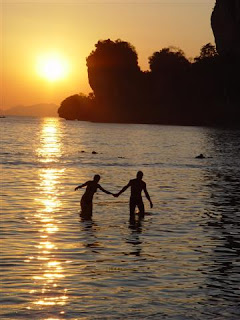
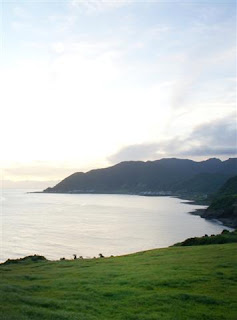
Silhouette with correct background exposure (left) V.S a clear foregroung but an overexposed backgroung (right)
It is said that the black card photography is a unique photography developed in Taiwan. Basically, black card photography uses a black card (could be anything that is dark with a characteristic of not refecting lights) to shelter the brighter area of an image allowing the darker area a longer exposure and the result is a balanced exposure. Compare to gradient graduated ND filter application and HDRI, black card photography can handle a greater dynamic range of luminance and it can be done without computer software post-editing which usually disqualifies a great photo from a photo contest. To get a balanced exposure in a high dynamic range of luminance environment with black card photography the first step is to set the metering mode to spot and measure the exposure at bright and dark areas of the scene respectively. Lets use this photo as an example:
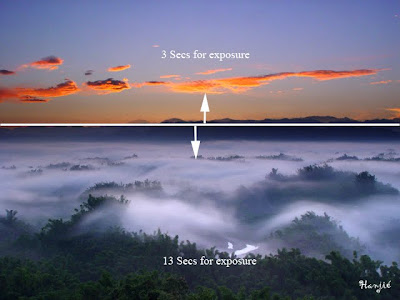
The exposure for the sky was measured 3 secs and 13 secs for the ground with F stop 8 (it was the smallest aperture I got on sony F717) in the spot metering mode. So I set the shuttle speed to 13 secs, F stop at 8, and focus to manual as the black card may change the focal point. The camera was mounted on a tripod, self-timer was on to minimize a blurry image from shaking the camera while pressing the shutter. Then I put a black card close to the lens and adjusted the position through viewfinder as the image below:
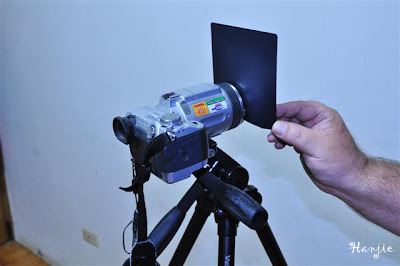
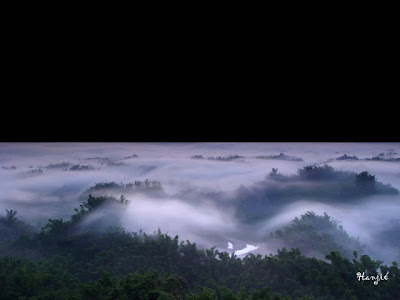
Once the shutter was opened, I kept shaking the black card up and down a bit to prevent the formation of a black card sheltered line like in the image below. Ten seconds later, I removed the card from the lens and let the whole image be exposed for another 3 secs until the shutter closed.
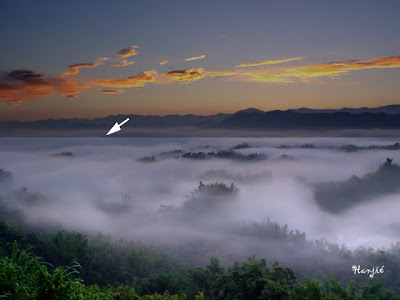
By doing so, the sky was exposed for 3 secs and the ground for 13 secs and as a result, a balanced image exposure was captured.
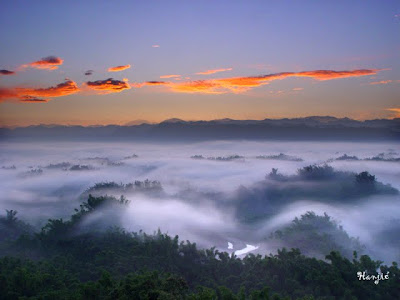 Here are some photos that were taken by black card photography
Here are some photos that were taken by black card photography
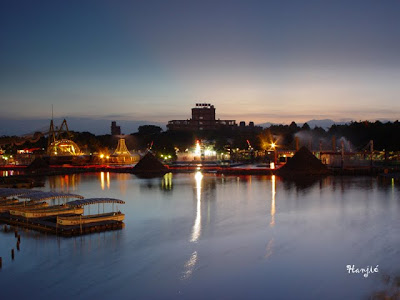
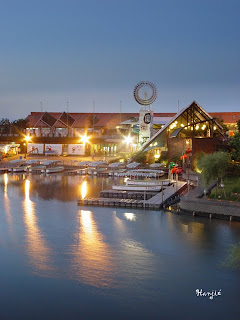
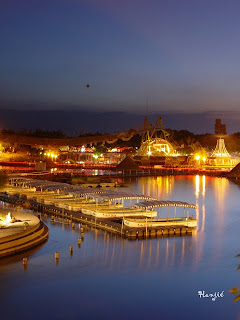
Tips:


Silhouette with correct background exposure (left) V.S a clear foregroung but an overexposed backgroung (right)
It is said that the black card photography is a unique photography developed in Taiwan. Basically, black card photography uses a black card (could be anything that is dark with a characteristic of not refecting lights) to shelter the brighter area of an image allowing the darker area a longer exposure and the result is a balanced exposure. Compare to gradient graduated ND filter application and HDRI, black card photography can handle a greater dynamic range of luminance and it can be done without computer software post-editing which usually disqualifies a great photo from a photo contest. To get a balanced exposure in a high dynamic range of luminance environment with black card photography the first step is to set the metering mode to spot and measure the exposure at bright and dark areas of the scene respectively. Lets use this photo as an example:

The exposure for the sky was measured 3 secs and 13 secs for the ground with F stop 8 (it was the smallest aperture I got on sony F717) in the spot metering mode. So I set the shuttle speed to 13 secs, F stop at 8, and focus to manual as the black card may change the focal point. The camera was mounted on a tripod, self-timer was on to minimize a blurry image from shaking the camera while pressing the shutter. Then I put a black card close to the lens and adjusted the position through viewfinder as the image below:


Once the shutter was opened, I kept shaking the black card up and down a bit to prevent the formation of a black card sheltered line like in the image below. Ten seconds later, I removed the card from the lens and let the whole image be exposed for another 3 secs until the shutter closed.

By doing so, the sky was exposed for 3 secs and the ground for 13 secs and as a result, a balanced image exposure was captured.
 Here are some photos that were taken by black card photography
Here are some photos that were taken by black card photography


Tips:
- Set F stop to 16-22 to get a greater depth of field (DOF)
- Use Manual mode and set the shutter speed to "Bulb" rather than exact time. The reason to do that is because when you have a longer exposure it is easy to make a mistake by counting too quickly or too slowly. By using "Bulb" mode, you control the shutter that avoids under/over exposure after removing the black card.
- Curve the black card to match the geography when the horizon is not a simple line.
- Use an ND filter to earn a longer exposure time if it is too short (especially for a sunrise image)
=========================================================
Thank you so much for correcting my mistake and sharing great tips in the comment section, Craig.
GND filter is indeed an easier way to deal a high dynamic range luminance environment and the result usually satisfying. However, lets take the most commonly seen GND8 filter in photo stores (ND=8) for example, the difference between the darkest part to the transparent part is 3 F-stops but that's not enough to handle the contrast between the bright and the dark areas in many sunrise/sunset scenes. Of course, apply multiple GND filters can solve the problem but it might also worsen the image quality as most of the GND filters are made of plastic. Moreover, given the property of graduated decreasing darkness of a GND filter, it is easy to get an uneven exposure in the bright area on the scene (darker on the top) if the bright area has a similar exposure value (EV). ( Example: notice a grafuated darkness from top to bottom on the image that applied a Gradual Grey2 (ND8))
Even though HDR has been accepted in many reputable photo contests, it seems to me most photo contests in Taiwan still have some issues about it. HDR is the easiest way to create a well balanced exposure image in a high contrast environment. The Photomatix Pro has a high reputation in making a HDR image, download the trial version here if you are interested. Stuck in Customs has stunning HDR photos and HDR tutorial.
It is highly recommended to set focus to manual when using a black card. The concern is not because the focal point might change during the exposure; depends on compositions, sometimes the black card covers 2/3 of the lens which can be a problem when the focus is set to auto. Thank to Craig's reminder, positioning the focal point at 1/3 of the scene in front gives you the rear 2/3 scene in an acceptable focal range, it's a great tip for manual focusing. If you are interested in how to set your focal point to get a greatest DOF, try to understand the concept of hyperfocal distance and Mountain Storm Fine Arts provides a great tool to calculate a hyperfocal distance. If you have a Windows Mobile phone, you can download WinMoDof, which is a useful free application that calculates the DOF and hyperfocal distance.
It's not necessary to set shutter speed to Bulb (the pics in the article weren't set to Bulb as Sony F717 has no such feature, you can download the pics for EXIF info). The reason that I highly recommended to set shutter speed to Bulb in black card photographing even when the exposure is under 30 secs is to minimize the effect of counting error. The error is inevitable and it gets bigger with a longer exposure time. Back to my example, the proper exposure for the sky and mountains were 3 and 13 seconds respectively. If the shutter speed was set for 13 seconds and I started to shake the black card while counting to 10 but I counted it too fast, so I removed the black card at 8 seconds which gave the sky a 5 seconds to expose, as a result, an overexposed sky would be captured; if I counted the time too slow, lets say the exact time I counted to 10 was 12 seconds that left the sky only 1 second to get exposure, an underexposed sky would be captured. When I set the shutter speed to Bulb, despite the counting error, I would get the whole image either overexposed or underexposed a bit rather than a partial over/under exposed image. With a Raw format, it's easy to compensate a 3EV over/under exposed image in the camera. Of course, if you are using a GND filter as mentioned by Craig, a proper metering will negate the need for counting.
Often times I got this question: should I expose the whole image first then cover the bright area with a black card when it got a proper exposure time or the other way around as I introduced in this article? The problem is if you let the whole image expose first then cover the black card it's difficult to place the card at a proper position. I meant to write a complete guide to black card photography but I only got a DSLR a few months ago and I simply didn't have the time to take photos for a such big topic. This article is the basic concept and practice of black card photography and all photos were taken by sony F717 which limited applications of a black card. How to use a black card in complex light sources environment and photographing fireworks with a black card will be the part II coming soon.
No comments:
Post a Comment